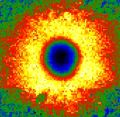Speaker
Description
Perovskite quantum dots (PQDs) represent a promising avenue for enhancing the efficiency and stability of perovskite solar cells (PSCs). The integration of PQDs into PSCs has been shown to extend absorption range, enhance photon harvesting, and improve device efficiency. Furthermore, PQDs offer the potential to stabilize PSCs structure by passivating surface defects and enhancing overall stability. The choice of ligands on the surface of PQDs significantly influences their incorporation into PSCs, impacting charge transport properties, interface formation, and device stability.
In this work, the effect of the CsPbBr3 QDs doping on the perovskite structure and optoelectronic properties was studied. The single-phase CH3NH3PbI3 (MAPbI3) perovskite and triple cation perovskite Cs0.05(MA0.17FA0.83)0.95Pb(I0.83Br0.17)3 (CsFAMI) layers were deposited on the ITO glass substrate by spin coating. The chlorobenzene (CB) was employed as the anti-solvent. For doping, the PQDs were mixed into the CB antisolvent. Three different concentrations of PQDs (0.05, 0.1, 0.15 mg/mL) were explored for perovskite doping. The preparation conditions were kept unchanged for a particular perovskite.
The CsPbBr3 QDs were synthesized by hot-injection technique applying cesium oleate, PbBr2, and two distinct ligands: oleic acid combined with oleylamine (OAOAm CsPbBr3), and didodecyldimethylammonium bromide (DDAB CsPbBr3). The scanning transmission electron microscopy analysis verified the uniform cubic structure and consistent shape of the CsPbBr3 QDs, demonstrating an average size ranging from 10 to 14 nm.
The UV-Vis absorption spectra indicate absorption edges for OAOAm CsPbBr3 QDs thin film at approximately 513 nm (band gap of 2.38 eV) and for DDAB CsPbBr3 QDs at around 490 nm (band gap of 2.33 eV). Moreover, the band gap of the pristine perovskite layers, MAPbI3 and CsFAMI, were determined to be 1.61 eV and 1.58 eV, respectively. The incorporation of CsPbBr3 QDs with both types of ligands into the perovskite with the concentrations the 0.05, 0.1, and 0.15 mg/mL resulted in marginal enhancements in the absorption for the MAPbI3 perovskite. No discernible alterations were noted for the CsFAMI perovskite.
Steady-state photoluminescence (PL) and time-resolved PL (TRPL) measurements were performed to study the effect of PQDs doping on the morphology and optoelectronic properties of the perovskite layer. The PL peak of the samples containing pristine and doped MAPbI3 and/or CsFAMI perovskite with CsPbBr3 QDs in different concentrations is observed for both ligands at 771 and 780.5 nm, respectively. The TRPL was measured at the wavelength where the maximum emission from the perovskite layer occurred. The TRPL data were fitted by bi-exponential decay models. Here, the fast decay PL component (t1) is related to the charge carrier trapping by trap states, and the slower component (t2) is assigned to the free carrier recombination.
For MAPbI3 doped with the DDAB CsPbBr3 PQDs, a small increase in the t1 and t2 components for 0.05, and 0.1 mg/mL doping concentrations was observed. A maximum increase of t1 from 9.9 ns for the undoped MAPbI3 layer up to 14.9 ns for the MAPbI3 layer doped with 0.15 mg/mL was found. For OAOAm CsPbBr3 PQDs, a similar maximal prolongation of t1 up to 14.9 ns was observed for 0.1 mg/mL doping. For the slower component, a maximum prolongation of t2 from 65 ns for pristine MAPbI3 to 88.9 ns for DDAD CsPbBr3 QDs 0.15 mg/mL doping and up to 106.2 ns for OAOAm CsPbBr3 QDs 0.1 mg/mL doping were found.
Slightly different behavior was observed for CsFAMI perovskite doped by CsPbBr3 QDs. For the PQDs with DDAB ligand in CsFAMI we found an almost unchanged t1 (9.9 ns for pristine perovskite vs 10.0 for 0.1mg/mL doping). For the t2 component, an increase from 64 ns for pristine perovskite up to 89 ns for 0.15 mg/mL doping was found. For OAOAm PQDs, maximum increase of t1 up to 20.1 ns was found for 0.05 mg/mL doping. For t2 maximum, an increase from 61.9 ns for pristine CsFAMI up to 100.8 ns for 0.15 mg/mL doping was found.
In summary, the CsPbBr PQDs doping could be effective for both MAPbI3 and CsFAMI perovskites. The increased values for t1 and t2 for all concentrations were observed, more pronounced being for the OAOAm ligand. This could point to the possibility of suppressing the charge carriers trapping as well as free carrier recombination at the grain boundaries by the PQDs doping.
The results will be completed by SEM, AFM, and XRD studies to analyze the effect of doping on the morphology.

